A PROSPECTIVE OBSERVATIONAL STUDY ON PREVALENCE AND INCIDENCE OF ANAEMIA AMONG GESTATIONAL WOMEN
Study of Anaemia in Pregnant Women
Abstract
Objective: This observational study aims to determine the prevalence and incidence of anaemia in pregnant women in the city of narsaraopeta, India.
Methods and Methodology: Information on total of 130 pregnant women who attended to ANCs from September 2023 to February 2024 were taken. Information about age, parity, educational status, no. of abortions, type of family, socioeconomic factors, dietary habits, were collected by using pre-designed questionnaire, and patient clinical data form. In this study we used a simple randomised sampling technique to select subjects.
Results: The study encompassed 130 patients from government and private ANC (Antenatal Care) care hospitals in Narasaraopet over six months. Pregnant women were predominantly aged 19-23 (49.62%) and 24-28 (37.40%). The distribution based on trimesters revealed 23.26% in the first trimester, 36.43% in the second, and 36.43% in the third. Regarding previous delivery types, graduates constituted 24.43%, illiterates 31.30%, and primary education holders 44.27%. The distribution based on the severity of anemia showed variations across follow-ups, with a significant proportion in the moderate category. Additionally, the occupation-wise distribution depicted a high percentage of housewives (65.54%) and varied percentages among others.
Conclusion:. Anaemia prevalence is highest in the third trimester, persisting across follow-up periods, with a significant proportion in the 19-28 age group, highlighting challenges in managing anaemia during pregnancy.
Downloads
All the articles published in JAPSR are distributed under a creative commons license (CC BY-NC-SA 4.0)
Under this license, you are free to:
- Share- copy and redistribute the material in any medium or format for any purpose, even commercially.
- Adapt- remix, transform, and build upon the material for any purpose, even commercially.
The licensor cannot revoke these freedoms as long as you follow the license terms.
- Attribution — You must give appropriate credit , provide a link to the license, and indicate if changes were made . You may do so in any reasonable manner, but not in any way that suggests the licensor endorses you or your use.
- NonCommercial — You may not use the material for commercial purposes .
- ShareAlike — If you remix, transform, or build upon the material, you must distribute your contributions under the same license as the original.
- No additional restrictions — You may not apply legal terms or technological measures that legally restrict others from doing anything the license permits.
Copyright policy
The journal allows the author(s) to hold the copyright of their work. That means the authors do not need to transfer the copyright of their work to the journal. However, the authors grant JAPSR a license to publish the article and identify itself as the original publisher.
Licensing policy
The journal allows the author(s) to hold the copyright of their work. That means the authors do not need to transfer the copyright of their work to the journal. However, the authors grant JAPSR a license to publish the article and identify itself as the original publisher.






